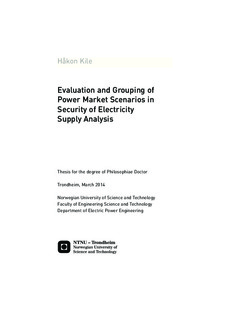| dc.description.abstract | In power system reliability assessment, at the transmission system level, a basic requirement of the analysis is models describing load and generation profiles at the individual buses, as these variables are needed as input to the power flow problem. As a consequence of deregulation and the increasing share of renewable energy sources in the generation system, the modelling of load and generation patterns has, over the last decades, become more difficult.
For electric power systems, it is often the case that a certain mix of load and generation (spread out at the individual buses) cause the system to be vulnerable, as it might lead to, e.g., too high load on certain transmission lines or too little generation reserve in certain areas. An important aspect of power system reliability assessment is to reveal and analyse such vulnerabilities. Thus, it is necessary to check different mixes of generation and load in conjunct with (a large number of) component outage combinations to reveal as many system vulnerabilities as possible.
Typically, only peak load situations are analysed in power system reliability assessments. However, the transmission system can be vulnerable due to bottlenecks in the system, as a consequence of large local loads and/or nondispatchable generation, even though the total demand might be well below the peak demand. To improve the generation and load modelling, the reliability assessment framework discussed in the thesis use a power market model to generate (future) load and generation scenarios. The generated scenarios are interpreted as a sample of future power market behaviour, and are used as basis for a reliability assessment. Depending on the type of power market model, this analysis can take into account different market structures, renewable energy sources, hydro inflow scenarios, etc.
The power market models tends to produce a large number of load and generation scenarios, and to include all these scenarios in a reliability assessment results in excessive computation time. In this thesis, the scenario selection method is proposed and discussed. The scenario selection method finds groups of similar load and generation scenarios, and then, for each group, chooses one scenario to represent the group characteristics. The set of chosen scenarios is denoted the representative set, and only this set of scenarios is used as basis for a reliability assessment. Essentially, the scenario selection method keeps the sample variation of the full sample of load and generation scenarios more or less intact, but at the same time severely reduces the computational requirements of the reliability assessment. Based on the results of the case studies in this thesis, these main conclusions (with respect to application of the scenario selection method) are drawn:
• Feature selection, i.e., selection of variables used for quantifying similarity among load and generation scenarios, is a case dependent process, and ideally the feature selection should be customised to suit the analysis to get optimal results. However, the power injections (P and Q at the buses in the power system under study) give good results when used as features for scenario selection, and is the best general recommendation.
• The problem of finding groups of similar load and generation scenarios is most likely a segmentation problem. Thus, there is no objective method for determining the number of natural groups k in the set of load and generation scenarios, and k must be selected based on experience. The results of the case studies indicate that k ≈ 0.1 · n is a sensible choice (where n is the total number of load and generation scenarios).
• In a segmentation problem, the goal of the clustering algorithm is to group together load and generation scenarios which are very similar. An agglomerative clustering algorithm, with complete linkage, tends to produce small and compact groups, and is therefore thought of as an appropriate algorithm for this problem. The results of the case studies support this assumption, as agglomerative clustering with complete linkage is, overall, the algorithm with the best results when applied for scenario selection. The k-means algorithm gives similar results as the agglomerative clustering algorithm, while more advanced clustering algorithms perform at the same level, or worse, than the agglomerative clustering algorithm when applied for scenario selection.
• The scenario selection method can reduce the computation time of the reliability assessment by about 90% (by setting k ≈ 0.1 · n), and simultaneously keep the error in the reliability indices within a 5-10% margin. This is thought of as an appropriate trade-off between reduced computation time and maintaining the accuracy of the analysis. An alternative method for reducing the computation time of the reliability assessment, is to only analyse those scenarios with the highest overall system load, e.g., exclude 90% of the load and generation scenarios from the analysis by taking away those with a “low“ system load. The scenario selection method is a more systematic and consistent method for reducing the scenario set compared to such (rule-based) methods, and it is shown that the scenario selection method gives much better results than such (rule-based) methods. | nb_NO |
